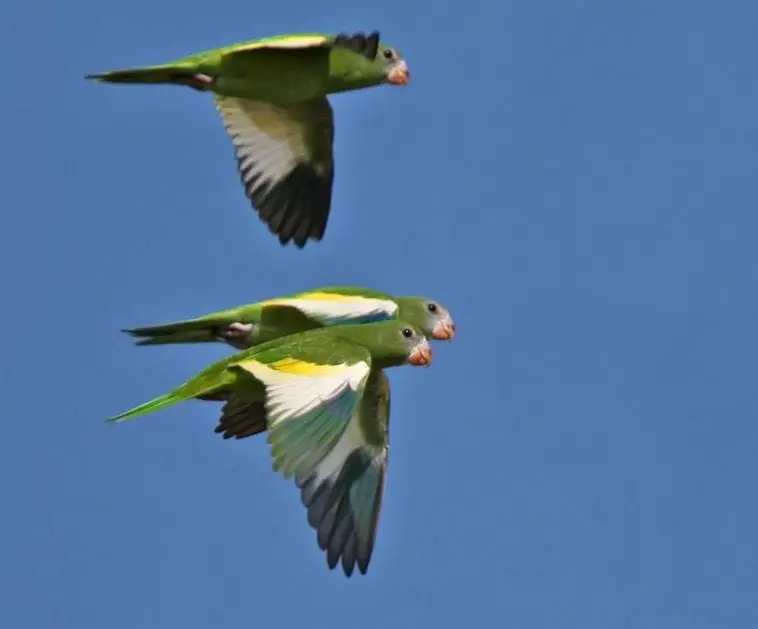Scientific Facts
| Common Name | White Winged Parakeet |
| Scientific Name | Brotogeris versicolurus |
| Origin | Amazon River that has a basin from the southeast part of Colombia to Brazil |
| Habitat | Savannahs, open forests, river islands, and seasonally flooded forests |
| Diet | Germinated seeds of plants, fruits and vegetables, fresh fruits, edible flowers, grains, and pelleted seeds |
| Size and Weight | Size: 8.5 to 10 inches (21 to 25 cm) Weight: 70g (2.4 oz). |
| Lifespan | Wild: 5 to 10 years Captivity: Up to 15 years |
| Clutch size | 4-6 eggs |
Physical Description
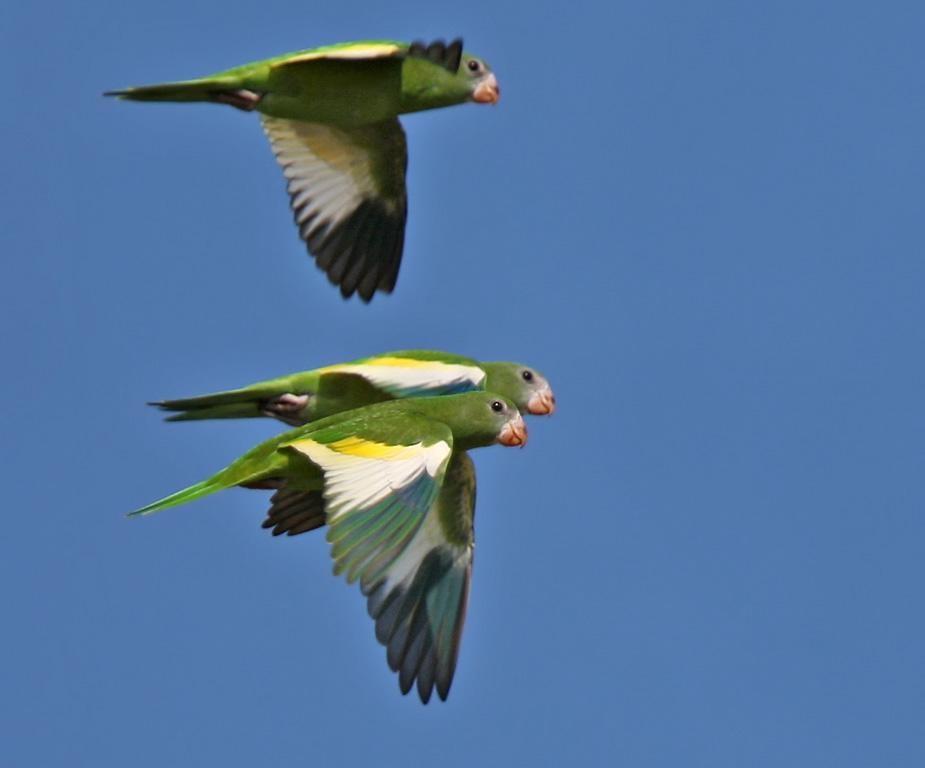
The white-winged parakeet is also known as the bee and the canary-winged parakeet. These bird species are usually bright green in color, while yellow and white patches on the wing part mostly seen when they fly. They have a long, pointing tail with a bill and legs with pinkish coloration. They have brown eyes and pale beak.
Where it is Seen?
White-winged parakeets are originally habitats of the Amazon River that has a basin from the southeast part of Colombia to Brazil. Due to the conservation of their populations, they were also traces of this species in Los Angeles, Miami, Florida, California, San Francisco, Loma, and Peru.
Habitat
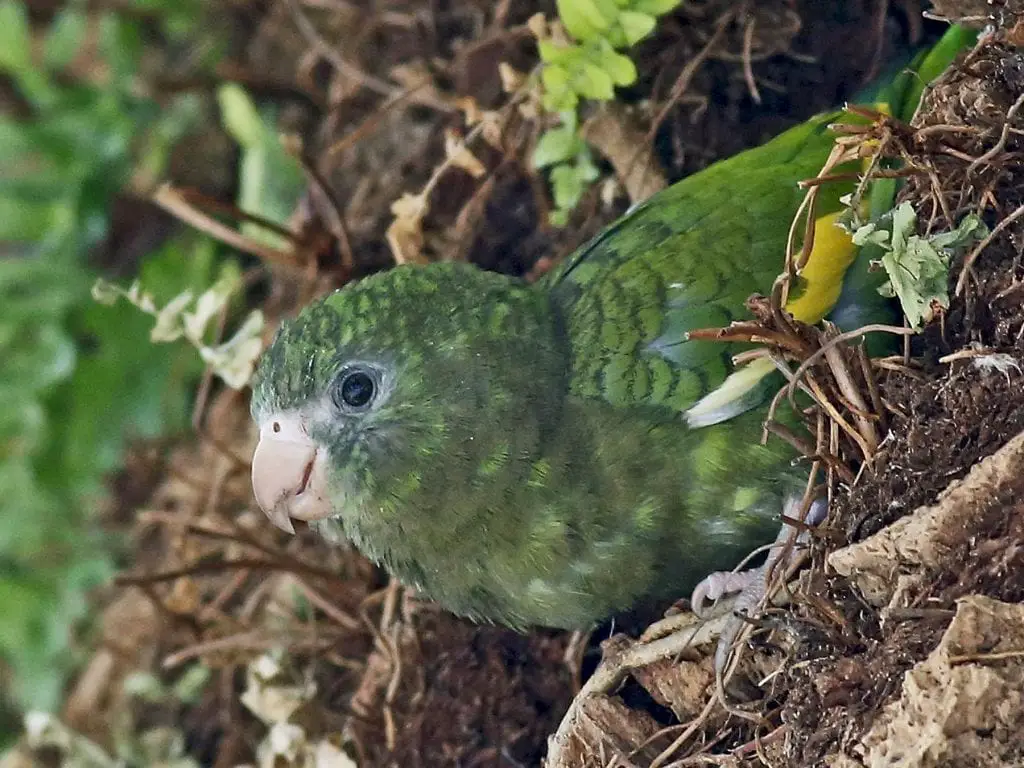
They thrive in or near savannahs, open forests, river islands, and seasonally flooded forests. They usually stay in small holes in the trees or tunnels made by the termites.
Behavior and Temperament
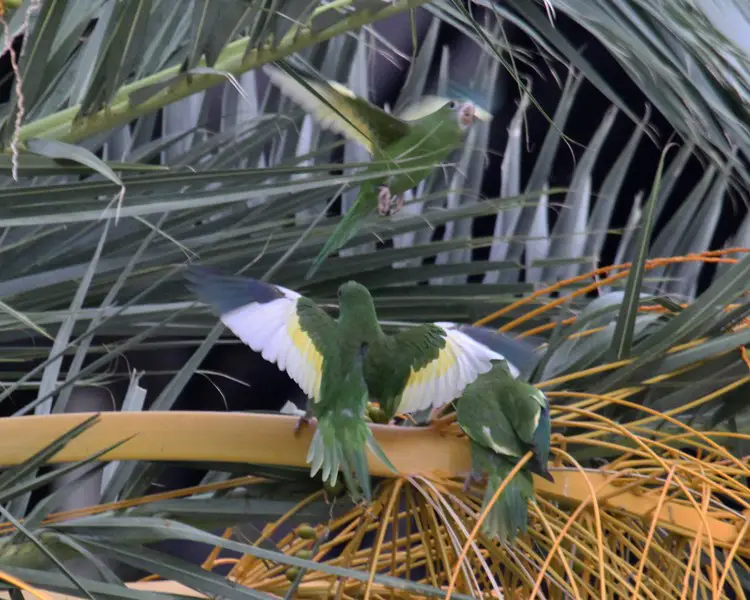
They are known for their charm that is adaptable and tend to be less picky about food. They may not talk often, but they are great whistlers. They love to spend time staying in flocks. When you notice that they raise their wings and make the clapping motion with it to make an explosive sound, it means that they are threatened. They are fond of climbing trees to mingle with their peers and to search for food.
In captivity, they spend their time foraging on their toys and chew their food. They are also quite curious about new things that they can see, so in captivity, make sure to always check what they are up to. Their ability to fly high in the wild allows them to enjoy different kinds of foods.
Body Languages of White-Winged Parakeet

Hopping
They are usually seen hopping in the tree branches or in the bara of their cage. This is an indication that they are in a good mood and that they are active and happy where they are in. If you see them stand in one foot, this also means that they are in a state of relaxation.
Open wings
There are a couple of reasons why they open their wings. If the temperature is too hot, it is possible that they are just trying to cool down. When they open their wings and make the clapping motion, it means that they are being threatened.
Feathers raised and the tail is placed on one side
This is usually done by a female white-winged parakeet during the mating season, where they show signs of submissive behavior to males before copulation starts.
Feathers flattened against their body
If your white-winged parakeet does this, it means that they are not comfortable in an environment where they are in and that they are afraid. This is one of their defensive mechanisms, especially if there is no place for them to escape or hide.
Cleaning feathers
In the wild, they clean their bodies by means of rolling in wet grass or leaves, but in captivity, they clean their bodies means of scratching their heads into their feathers or other parts of their body to remove dust. This is a good sign that your bird is feeling comfortable and secure.
Silence/motionlessness
If your white-winged parakeet shows signs of timidness or motionless, it means that there is something wrong, usually with their health. If they do not eat, sing, hop, or move, be wary because your parakeet may be sick.
Diet
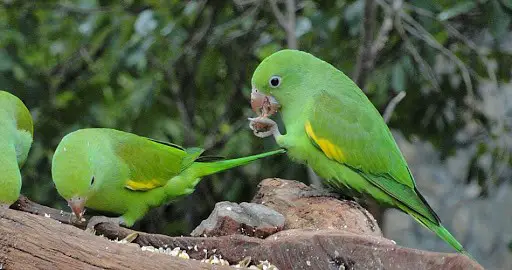
They mostly feed on seeds and fruits found in their native habitat. In captivity, they are usually given vegetables, fresh fruits, grains, and a pelleted diet. For their treats, they love to eat cooked chicken, eggs, or cooked beans. To prevent calcium deficiency, you may need to place a cuttlebone or mineral block into their housing.
These are the list of foods that you can give them:
- Germinated seeds of plants, fruits, and vegetables
- Fresh fruits such as berries, rose hips and figs
- Different types of edible flowers
- Nectar such as honey, porridge oat flakes, and wheat germ
- Half-ripe corn
- Green foods such as clover, chickweed, dandelions, and rowanberries
Breeding and Reproduction
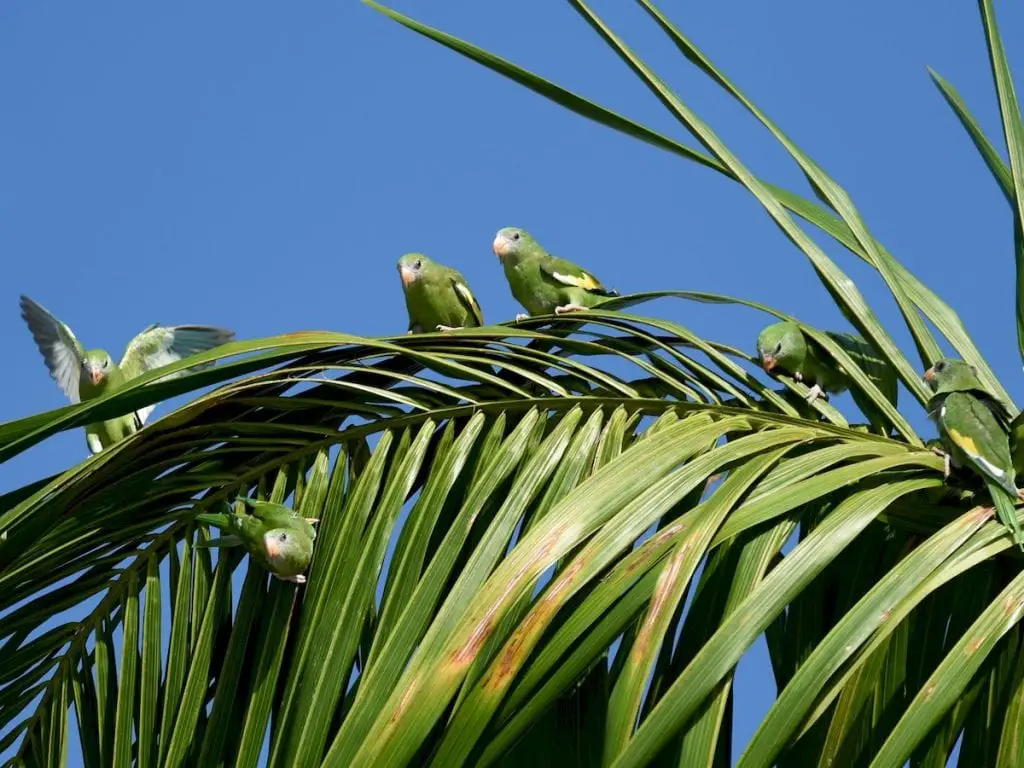
During the mating season, a flock of white-winged parakeets may perform a series of calls or loud noise to strengthen their flock, alert for threats, and defend their nesting sites. White-winged parakeets reach their sexual maturity for about 2 years old. The breeding season takes place from January to July. They are considered as cavity-nester, where they can lay their eggs in the hole of the trees, termite tunnels, or in a dead leaf-like palm or fern.
They lay about 4 to 6 eggs, which they incubate for about 21 days. The females are the only ones who incubate the eggs, but the males would still stay on the nest assisting the female, especially in terms of food. When the eggs hatched, it would take about 50 to 60 days for the youths to develop their feathers.
Size and Weight
They are a small and stocky bird species that grows about 8.5 to 10 inches (21 to 25 cm). Half of its length is the size of its tail, which is about 4.3 inches (10.8 cm). Theirs weigh about 70g (2.4 oz). There are no significant differences in the size and weight of both males and females.
Life Span
Like other mammals, their lifespan in captivity is longer than their lifespan in the wild. Their lifespan in the wild is up to 10 years while in captivity, they can reach up to 15 years.
Common Disease/Illnesses

Avian pox
This viral disease is known to infect at least 60 species of birds, including the white-bellied parrot. The symptoms lesions on the unfeathered parts of their body, such as their eyelids, feet, legs, and around the beak and mouth area. In many cases, birds die when they have difficulty opening their eyes and locating their food due to eyesores. This is easily spread when mosquitoes feed on the blood of an infected bird and transfer to a healthy bird.
Salmonella
This is common for feeder birds wherein the bacteria comes from an intestinal-tract infection. If your bird is infected, your child may experience ruffled feathers and diarrhea. As soon as you see these symptoms, take your bird to a veterinarian because usually, this disease can kill them for about 3 days only. If you place more than 1 bird in a cage, remove the infected ones because this disease can spread rapidly. Salmonella is also transmittable to humans, so be sure to wear protective gear.
Trichomoniasis
This is caused by a cell called protozoa, which is infected. This is a disease that infects almost all bird species. This disease is evident through the sores in their throat and mouth, and they do not have an appetite for food because of the inability to swallow. When a particular infested bird drops the food from its mouth, and other birds feed on it, except that the disease will be transmitted easily.
Mites and Lice
Then the bird is infested with large numbers of blood-sucking mites. It may be a cause of anemia and later on death. If their nest is infested with feather mites, the adults may leave or abandon their eggs without incubating it.
Aspergillosis
This is a fungal infection that comes from an unsanitary environment where the bird is exposed to wet nesting materials and contaminated food. Your bird will have respiratory illnesses such as bronchitis and pneumonia due to the inhaled spores. If you notice that your bird experiences labored breathing, diarrhea, and weaknesses, take them out and for diagnosis.
Preventing Illnesses
These diseases and illnesses that can affect the overall health of your parakeet are totally avoidable if they are staying in captivity. By simple ways of maintaining the cleanliness of their cage, it could definitely make a huge difference. It is also advisable to always observe how they behave because if they are sick, you can easily detect it through the way they behave.
Captive Breeding

White-winged parakeet is a common bird species taken in captivity, but if you decide to get one, it is advisable to at least get it in pairs because they have a greater need to have company. If you only have one, you may need to spend time to play or socialize with them every day to satisfy their needs for the company. They are an active bird species; that is why you may need to use a large cage for them to move freely.
Availability – Where to Get One
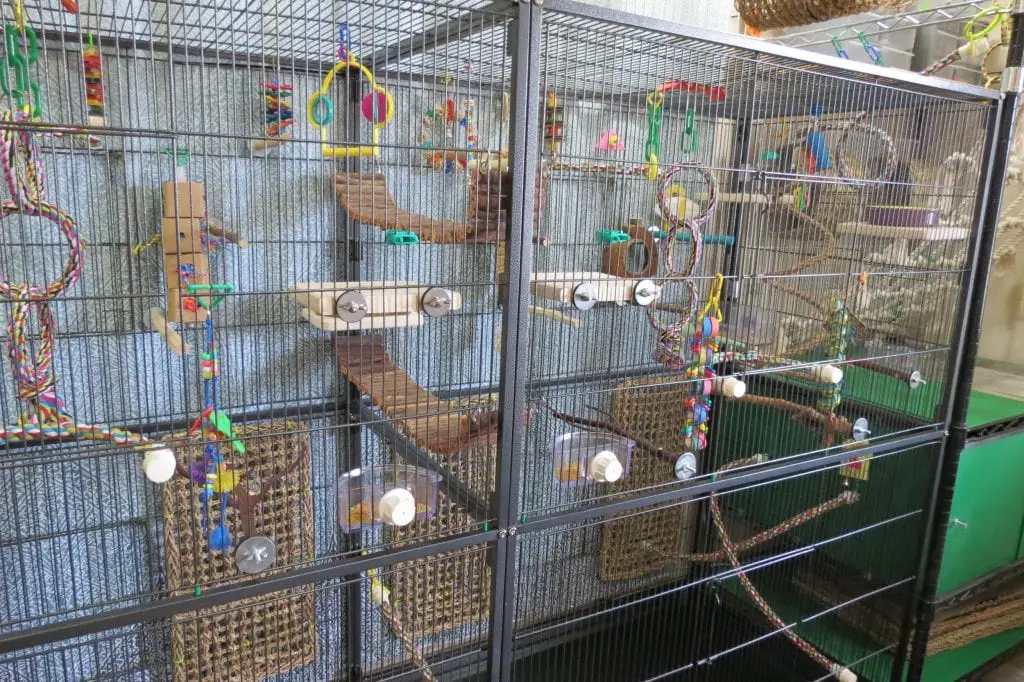
In searching for a white-winged parakeet, you need to choose a reputable breeder so that you would be sure that you are getting the parakeet that has a pure breed and to make sure that it is healthy. If you are to purchase from an online store, check the reviews and feedback from their previous customers. If you are to purchase from a physical store, see to it that the bird that you are eyeing for stays in a hygienic environment.
How to Care Parakeet as a Pet
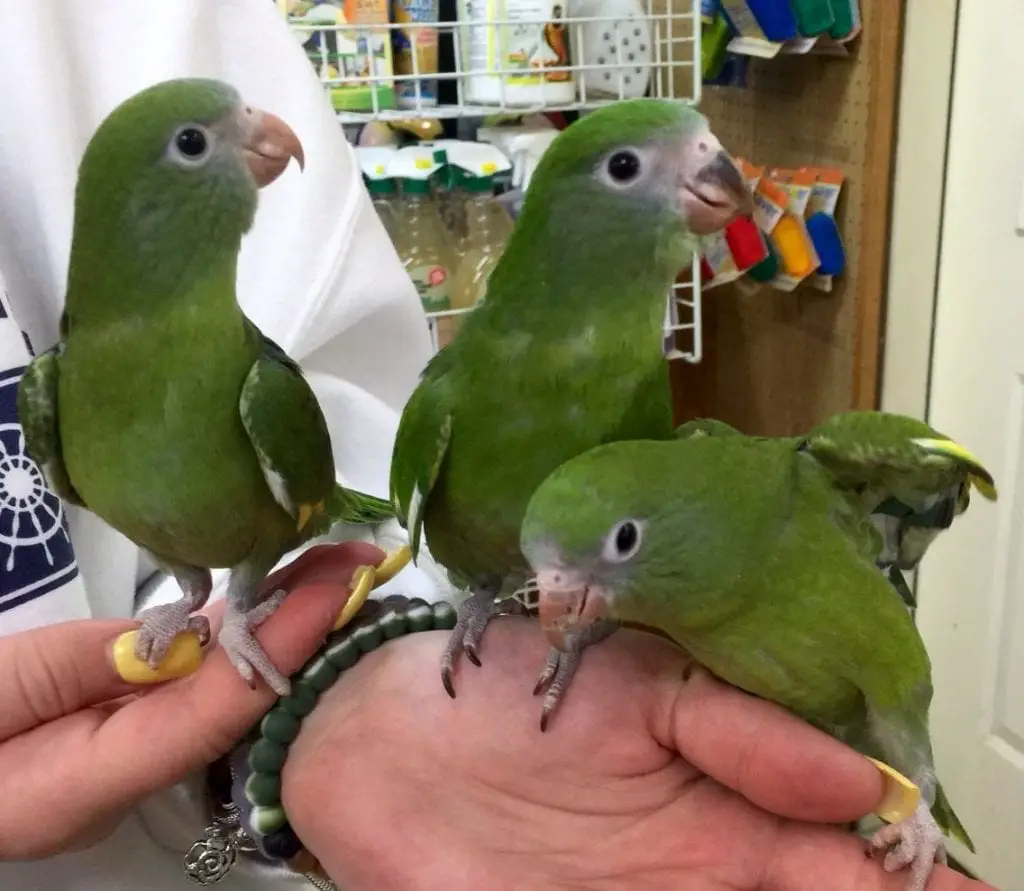
Housing
Your goal as a responsible breeder is to make sure that their housing should at least mimic their natural environment. If you are housing 2 or more parakeets, the bigger cage used, the better. The usual cage size is about 16x14x18″. Place the cage, whether outdoors or indoors. If placed outdoors, you need to protect the cage with a covering to make them safe when the temperature drops at night while when you place the cage indoors, make sure that the cage is placed near the windows, they are quite sensitive to odors especially to cooked food. The cage should be placed at eye level.
Substrate and Accessories
White-winged parakeet is a good sleeper; they sleep up to 10 hours daily; that is why their cage should have a comfortable place where they sleep. You can place a hanging fleece-lined hut on top of their cage. At the bottom of their cage, it is best to place aspen wood pellets, corn cob bedding, and cage liners, or recycled paper. Their flooring must be cleaned weekly, especially that this is where there defecate was drop. It is also important to place a piece of branch or a thick stick where they can stay most of the time.
Food
In captivity, they are usually given pelleted seeds on a daily basis with dark leafy green vegetables at least every other day. As their treat, you can give them fresh fruits such as melons, bananas, and apples for at least once a month. Aside from their food, you need to always supply them with fresh water. You can easily tame them, or they can get used to your presence if they often see you feed them.
Temperature
In general, parakeets are quite sensitive to changing temperatures. They love average household temperatures with at least 80°F (27°C). If you placed them outside, make sure they are under the shade so that they do not stay directly in the sun; at night, you may control the temperature by covering their cage with a blanket or any piece of cloth.
Handling
To ensure that your parakeet will not be bored, you may socialize with them for at least a couple of minutes a day. You can also train them so that your bond gets stronger and so that their mental functioning will be enhanced. If they are not receiving regular attention, there is a possibility that their interest in an interaction will be gone making them shy or aggressive around humans. If you interact with them, they’ll perceive that you are part of the flock. You can enhance their sense of sight by means of placing an interesting object in their cage, such as a mirror.
You can enhance their sense of hearing by talking to them frequently or playing the radio with a relaxing tune. You can enhance their sense of taste by feeding them different kinds of foods with different flavors and make sure to give it to them creatively, such as in a dispenser, or you can hang it for them to discover. You can enhance their sense of smell by means of giving them mint or citrusy edible that they can chew, and their sense of touch will be enhanced if you will give them objects or perches with varying textures.
Cleanliness
White-winged parakeet enjoys bathing; that is why it wouldn’t be difficult to instill cleanliness in them. You can bathe them like they have a shower, or you can make use of a mist spray to make them clean and refreshed about twice or thrice a month. Another part of their hygiene is the trimming of their nails and wings.
These are usually done by pet groomers because there is a proper tool that is appropriate so as not to hurt them. You can clean their whole cage for about once every month, and it is also advisable to scrub their food and water bowls and their toys to avoid bacterial infestations.
Facts About White Winged Parakeet
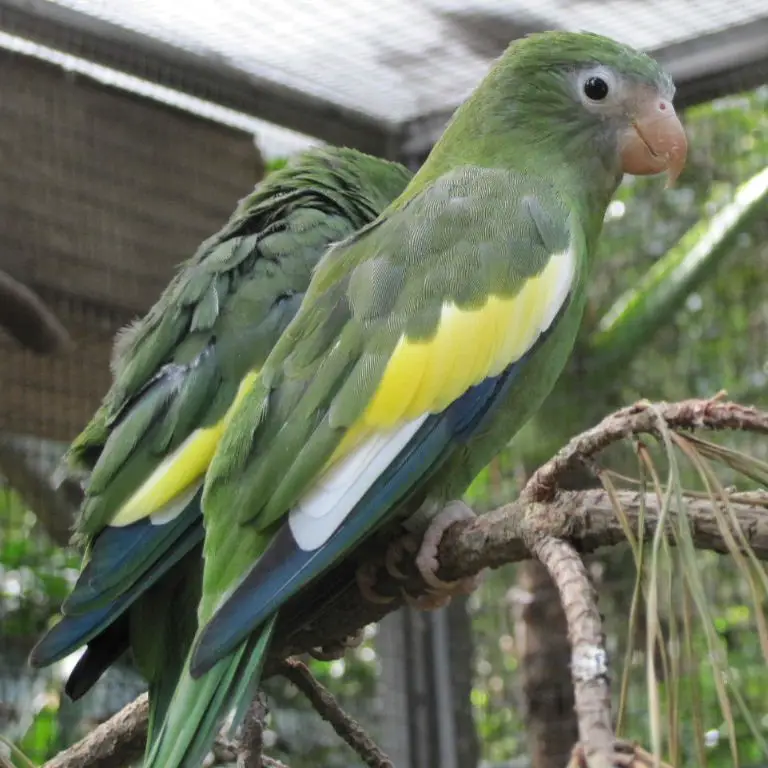
- Before the year 1997, the name canary-winged parakeet pertains to both yellow-chevroned parakeet and canary-winged parakeet, but as time goes by, this name was exclusively given to white-winged parakeet.
- Males and females do not vary significantly in terms of weight and size, but they can be distinguished through the fleshy skin above their beak, which is the cere. The females tend to have a tan to brownish-colored covering while the males have a bluish beak covering.
- White-winged parakeet has an X-shaped toe that has two ties oriented backward and two toes oriented forward. They also have the ability to move and rotate their heads for 180 degrees.
- With a normal body temperature of about 38.8 degrees, they have the ability to produce a heartbeat of 200 beats per minute.
- They are considered as a nomadic bird that is known to always change location in the wild. They are able to travel miles just to look for food and water.
- White-winged parakeet cleans and refreshes their bodies by means of rolling in wet grass.
- In an ideal environment, they can live in large groups known as flocks consisting of a thousand birds.
- During the breeding season. The males provide food for the females as well as to their offspring.
Conservation Status
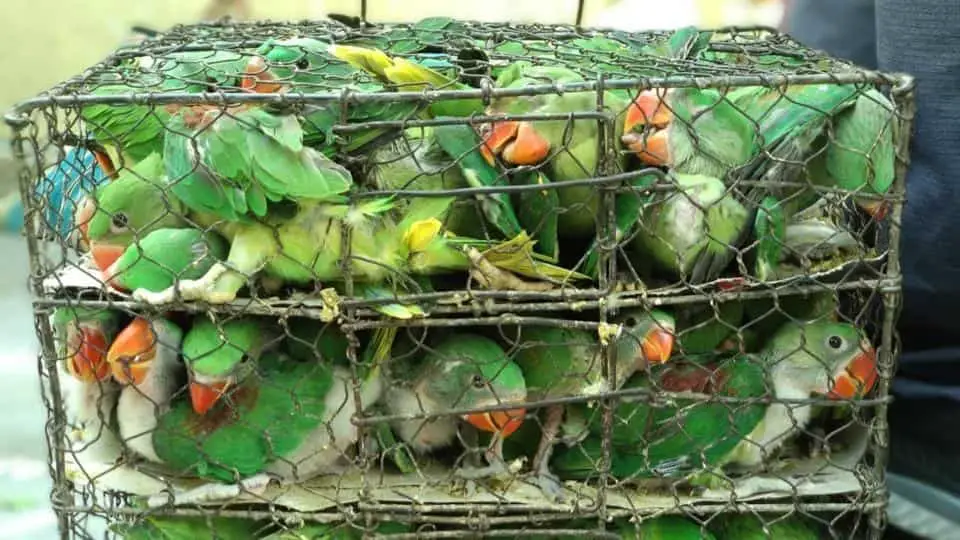
White-winged parakeet is under the least concern population stability. Their population, as of the moment, is not threatened within their native habitat, but those who wish to take them in captivity are advised to breed to somehow increase their population. The possible reasons that may decrease their population in the wild are due to the destruction of habitat, illegal hunters, and deforestations.
FAQs
Are white-winged parakeets good pets?
They are a good pet to be taken in captivity because of their behavior and temperament, but they are considered as semi-noisy birds; that is why it is not applicable if you get easily irritated by noisy environments.
Are white parakeet winged friendly?
They are naturally friendly, wise, and easy to tame. However, when they are threatened or feel stressed, they can also bite aggressively, so it is always advisable to be cautious.
Can I place two males white-winged parakeets in one cage together?
They are used to staying in flocks, so definitely, your parakeets can stay in one cage happily and healthily even if they have the same sex. Studies show that if a parakeet is living alone, they are more susceptible to stress and illnesses, lessening their lifespan.
Why does my white-winged parakeet seem singing?
If your parakeet sings, it is a sign that they are happy and healthy. This can be a nice behavior shown by your parakeet. However, if it causes disturbances, especially if someone is still sleeping, you can place the bird into another room, or you can place a blanket over the cage to trap the noise.
How much food does a white-winged parakeet eats?
The amount you give your parakeet is varying, but the usual amount is about two teaspoons of bird seeds a day. Your veterinarian can determine the amount of food you can give your pet.
Are canary winged parakeets produces loud noise?
They have the ability to produce loud tweets and noises, especially if they are playing, threatened, or seeking attention; that is why they are not a recommended pet if you are living in a closed apartment because your neighbors might be disturbed.
Do parakeets talk?
Parakeets do not have the ability to have conversations, but they are usually trained so that they can be able to repeat a handful of phrases or sounds they hear from humans.
Do parakeets pee?
They do not literally pee, but their defecate or dropping would consist of both white uric acid crystals and reproductive products that will pass through the ureters of their cloaca.
Do white-winged parakeet fart?
These birds have short intestines that are why they defecate often. They do not fart because they do not retain intestinal gas.
How can I play with and groom my parakeet?
You can play with your parakeet by placing toys inside their cage or letting them go out of their cage and letting them go around your arms. Personally grooming them is not advisable unless you’re knowledgeable and equipped with tools.
How can I keep my parakeet healthy?
When they are just taken in captivity, it is advisable not to handle them for about 4 days. Make sure that they get used to their new environment first

